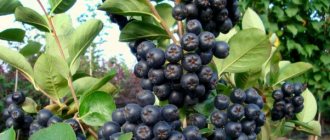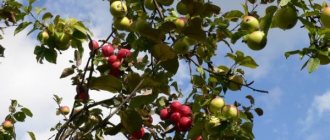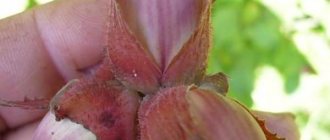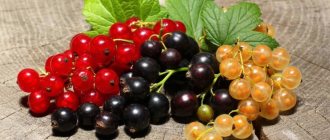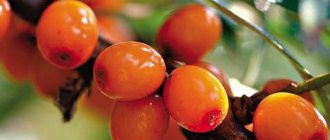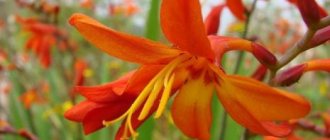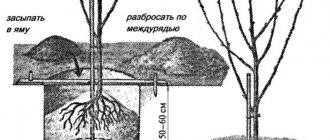Replanting rowan from the forest in the fall. How to plant rowan in the fall?
In order to plant rowan, you need to choose one-year or two-year-old seedlings. Rowan will grow equally well in both shaded and sunny areas; it loves not stagnant, but moist places. It is not very demanding on soils, but does not tolerate alkaline soils, soil compaction near the tree trunk, or the presence of any weeds. If the soil is very acidic, it is recommended to carry out liming in advance. Prefers to grow on sandy and loamy soil.
Rowan can be planted both in spring and autumn. September is considered the most suitable month for this process. For planting, dig a fairly spacious hole measuring about sixty centimeters by sixty centimeters and fill it with good humus soil. And don’t forget to spill it thoroughly. Six hundred grams of superphosphates, twelve kilograms of humus and one hundred and fifty grams of potassium salt are added to the prepared pit. They also make a ten to twenty centimeter drainage layer of crushed stone. If I plant several trees, the distance between them should not be less than five meters. Also pay attention to the level of the root collar after the soil settles; it must be at the same level as the ground.
Then they make a small mound in the very center of the hole, straighten all the roots on the seedling and cover it with earth. If you bury the rowan during planting, it will produce quite a lot of root shoots, which must be cut out every time, right down to the very base.
In order for the soil to adhere well to the roots, it is necessary to thoroughly water each layer at the exact moment when the soil is poured into the hole. This way, voids will not appear under the roots. The soil around the planted rowan should not be compacted too much; very often this is done with the help of feet, since it is already very compacted, which does not allow microorganisms to work actively. In addition, in very dense soil, the roots have poor air circulation, which they really need. If a very tall tree is planted, then first of all it must be tied to a stake. But it is recommended to drive three stakes, tilt them towards the seedling and tie them together. Planting rowan will thus be safer and more reliable for the plant itself.
Rowan tolerates transplantation very well. However, it is worth remembering that it has a deep root system, and therefore planting material must be dug very deeply. If you can vaccinate, then you need to dig up a small mountain ash in the forest and transplant it to your site. After the plant takes root, this will happen next year, then in the spring you can graft several cuttings of different varieties onto it at once. As a result, you can get rowan for every taste. In this case, you should always cut off the root shoots. Otherwise, all your newly grafted cuttings will begin to die off, and only the wild ones will remain.
Advantages and disadvantages of autumn transplantation
When replanting chokeberry from the forest in the fall, not only climatic conditions are taken into account, but also the condition of the plant. Autumn planting brings with it positive and negative aspects.
The advantages of transplanting mountain ash from the forest in the fall include:
- after planting, the trees will begin to grow three weeks earlier, unlike in spring;
- less time is spent on caring for shrubs, since the level of soil moisture and temperature is controlled by nature itself;
- saving time, since there is less work in the garden in the fall than in the spring;
- At this time, you can appreciate the root system of the tree and understand how it will develop in the future.
The disadvantages of autumn work are:
- if the region has frosty winters, then there is a possibility of the root system freezing;
- strong winds can damage the bush and break off weak and young branches;
- an attack by rodents is possible, which actively attack the garden in the fall.
Rodents may not completely destroy the tree, but they will prevent it from blooming in the spring. This means there will be no harvest.
How to replant rowan in the fall. How to plant rowan in the fall?
Autumn planting differs from spring planting in many respects. In order for mountain ash, planted before the onset of cold weather, to take root in a new place and grow well, it is necessary to adhere to time-tested rules.
Selection of seedlings
- The root system should be moist, without visible damage, with 3-4 main branches and 25-30 centimeters long.
- The presence of wrinkled bark indicates that the planting material was overdried.
- The crown should also be well developed; the presence of a main conductor and main branches is very important.
During transportation, the roots of the seedling are wrapped with a damp cloth and placed in a plastic bag.
Preparing a seedling for planting:
- Before planting, it is necessary to remove all dry and damaged branches, the same rule applies to the roots of the tree.
- For best hydration, the root system of the seedling is placed in a clay mash for 2-3 hours.
In order for all the tree’s strength to be spent on growth and adaptation in a new place, it is necessary to remove all green foliage.
Rowan seedlings ready for planting
Selecting and preparing a place for planting or replanting a tree
Rowan is famous for its unpretentiousness and ability to take root on various soils. But in order for the tree to grow and bear fruit better, the following conditions must be observed:
- The best option would be loamy or sandy loam soil.
- The soil should be loose and neutral, the presence of expanded clay drainage is welcome.
- Rowan loves sunlight very much, so it is better to choose a non-shaded area.
- The soil must be well moistened.
- It is desirable that the groundwater level be below 1.5 meters, but mountain ash also tolerates a closer location.
Rowan is planted at a distance of 4-5 meters from other trees. Approximately 2-3 weeks before planting the seedling, it is necessary to prepare the planting hole, it should have time to settle.
- The depth of the hole is 40-50 centimeters, the width will depend on the size of the root system of the seedling.
- The fertile soil layer is mixed with:
A bucket of compost or humus;
150 grams of superphosphate;
300 grams of wood ash.
- One third of the hole is filled with the resulting mixture.
- Then half of it is filled with infertile soil.
Planting rowan in open ground:
- Before planting, pour a bucket of water into the prepared hole and wait until it is absorbed.
- Then a seedling is placed there, which needs to carefully straighten the roots.
- The root collar should be 5-7 centimeters above ground level.
- When filling the hole, it is recommended to shake the tree slightly to fill all the air pockets.
- After the rowan is planted, the soil around the tree trunk is carefully compacted and thoroughly watered.
- At the final stage, you need to mulch the tree trunk with humus or peat.
Watering rowan immediately after planting
Care after landing
In order for the tree to form correctly and grow strong and healthy, it needs to be properly cared for in the first years of its life. To do this, adhere to the following rules:
- For the first 2-3 years, rowan is not fertilized, because it will lack the nutrients added during planting. An exception would be nitrogen fertilizers that stimulate tree growth. They can be applied from the 2nd year of planting.
- When watering, 2-3 buckets of water are consumed per rowan tree. Water the tree 4-5 times per season; if there is heavy summer rainfall, you can leave only spring and autumn watering. After each application of moisture, the soil must be mulched.
Rowan is watered along furrows or using special grooves.
- In autumn, the soil around the trunk is dug up to a depth of 10-15 centimeters. Throughout the season, the soil around the tree should be kept clean and loose.
Further care
Overgrowth quickly forms at the root collar of the rowan , so gardeners regularly remove it with a hoe or by hand. They also monitor the formation of weeds that actively germinate in wet weather. To slow down their development, once a week the soil is loosened to a depth of no more than 5 cm. At the same time, the tree trunk circle is mulched with hay, grass, pine sawdust and leaves. Mulch prevents the development of insect pests, improves the condition of the earth's microflora, and protects against drought and frost.
In the first 2-3 weeks after planting, the seedlings are watered generously with water at room temperature . This is done in grooves dug at a distance of 20 cm from the plant. One young rowan requires about 8 liters of water. If it rains often, the amount of moisture is reduced.
Attention! Rowan is fertilized only from the third year of life. At first, the plant needs complex fertilizers, which are placed in the hole when planting.
In the first year, it is important to carry out preventive measures to protect the crop from diseases and pests. Common insects - aphids, midges, sawflies, common diseases - anthracnose, gray and white spots, scab. For spring treatment, Oxychom or Abiga-Pik products are used. Contact fungicides are designed to combat viral and fungal diseases and pests.
Rowan oakleaf planting and care. Rowan varieties in the photo
Breeding work was carried out with mountain ash. As a result, several dozen varieties were obtained with berries larger than those of the wild-growing form. Some varieties are free of natural bitterness.
Pomegranate rowan, description – a variety selected by Michurin with large berries, without bitterness. The fruits are burgundy-red, with yellow flesh, the weight of one apple is up to 1.6 g. The ascorbic acid content is increased - up to 30%. The tree is low-growing, easy to care for, but short-lived.
Grenade
Rowan liqueur - a variety with dark purple apples. Aronia was involved in its breeding. Very winter-hardy, small in size, with an ovoid crown, loves light, but also grows in partial shade. Planted singly and in groups. The variety is old, bred by Michurin.
Liquor
Burka is an undemanding variety that is resistant to diseases. Short, compact. Bitter-tasting berries up to 1.2 cm in diameter.
Varietal trees produce sweeter and heavier fruits, but they are not frost-resistant enough and can die in cold regions in harsh years. Species plants and hybrids do not have this disadvantage.
Oakleaf rowan (sorbus hybrida) is a mixed form between ordinary and mealy, planting and care are standard. The apples are not bitter, they are large, the harvest is plentiful - in favorable years there is no greenery visible behind the fruit. In temperate climates it blooms in late spring. The fruits are orange with a felt coating.
Oakleaf
Swedish rowan (sorbus intermedia) is a separate species used for landscaping. The fruits are mealy and become sweet by the end of October when ripe. In Europe, it is planted on streets and parks as an ornamental plant that is resistant to polluted air. Begins to bloom at the age of 7.
Swedish
Elderberry rowan (sorbus sambucifolia) - grows in the Far East all the way to Japan. This is a shrub with numerous stems reaching a height of 3 m with a spherical or elliptical openwork crown. The flowers are bright pink or snow-white, the apples are 1.5 cm in diameter, tasty, not bitter, and can hang on the branches all winter. Winter-hardy, very undemanding to soil, but sensitive to shading and does not take root well after transplantation. In warm years it may bloom a second time. The species is highly decorative and is used to form green fences.
Preparing rowan for the winter season
Only the planted rowan does not have time to fully become strong before the cold period sets in, for this reason it must be prepared for the winter season. For this purpose, certain work is being carried out.
The trunk is wrapped with burlap, after which insulation is carried out with spruce branches.
The bottom of the trunk needs to be additionally protected; it is buried with snow; make sure that the snow level does not become smaller and does not expose the trunk.
To avoid sunburn, the trunk must be whitewashed.
They protect the trunk from rodents with specialized poisons scattered in a circle near the trunk.
Where to plant rowan on the site. Proper planting of red rowan seedlings on the site
We will tell you how to plant rowan on a plot so that it gives the best results.
Important! If you cannot immediately plant the purchased seedlings, then bury them in a shaded place for a while (up to 3-4 weeks). Make a shallow hole at an angle (to the south), place a seedling in it and cover the roots and shoots halfway with soil. Water thoroughly. If the plants dry out too much, place them in water for a couple of days.
Best period for planting
Many people are interested in the question: when can you plant rowan? The answer is not clear-cut. Planting is possible in early spring, but only until May, since the seedlings grow early and bear fruit later. Proceed as soon as the soil allows.
But it’s better to plant in the fall, a couple of weeks before the soil freezes. The soil is warmed up and has not yet cooled down, which will help the plants adapt faster; over the winter they will be able to take root, the soil around them will settle well and become compacted, and in the spring they will actively begin to grow.
Choosing a landing site
If you are wondering where it is better to plant rowan, then pay attention to the places at the edge of the site. This way you will provide the plant with an unshaded growing area (this will have a positive effect on its life, since it is more light-loving), and its crown will not shade other plants. Suitable as an excellent background; herbaceous deciduous trees are considered a suitable company for rowan. Also combined with maple,
As for the choice of soil, the most common one is suitable for mountain ash, but on neutral, well-drained soil the yield will be higher, and on light, sandy, sandy loam soil it will be lower and growth will be worse. It will not suffer from close presence. Before planting rowan, it is advisable to give the selected place for two years for growing grain crops.
Preparatory work on the site
Preparatory work begins with the arrangement of pits at a distance of 3-6 meters. The depth and width of each is on average 60×60 cm (take into account the size of the root system of the seedling). Place a layer of drainage on the bottom (broken brick, coarse crushed stone, expanded clay are suitable). Mix fertile soil, peat compost or (5 kg), (150-200 g), (100 g) and fill a third of the planting hole with the resulting mixture. Next, fill halfway with regular soil and water generously.
Preparing rowan seedlings
The preparation is very simple. Get rid of diseased, broken, dried roots. The above-ground part of the seedlings also requires the same manipulations. Use a clay mash for the roots to avoid drying out.
Important! If planting occurs in the spring, then the roots are first kept in water for two days. And from seedlings purchased in the autumn, you need to carefully remove the leaves without damaging the buds; if you purchase it too late, bury the rowan for the winter.
The process of planting rowan seedlings
Wait until water is absorbed into the soil after watering and make a small depression in the center of the hole, place the seedling there and straighten its root system. Cover the plant with soil so that it is 2-3 cm deeper than it grew in the nursery. Compact the soil slightly and water thoroughly again. Mulch the soil with a layer of humus, or other hay, straw) 5-10 cm thick.
Autumn planting dates
The time of autumn planting is determined by the climate of the area where the mountain ash will grow:
- In the central region, the best period will be mid-September - mid-October.
- In southern latitudes, it is best to plant rowan from early October to early November.
- In the northern regions, the entire period of September - early October will be acceptable.
- For Siberia and the Urals, autumn planting is most suitable, because spring in these areas is not stable, there is a risk of frost or, conversely, extreme heat. While autumn proceeds with comfortable temperatures and sufficient precipitation.
If planting dates have been missed, the seedling must be preserved until spring. In this case, use one of three existing methods:
- Basement storage:
- The roots of the seedling are lowered into a container with wet peat, sand and sawdust.
- The room must have comfortable conditions (air temperature from 0 to +10 degrees and 85-90% humidity)
- Once a week, the root system is additionally moistened.
- Dropping:
- A deep hole is dug in the area and the roots of the seedling are placed there at an angle of 45 degrees.
- It is then buried using a moistened mixture of sand and peat.
- Snowmaking:
- The seedling must be wrapped in a damp cloth and buried in the snow in this state. In this case, the optimal temperature for it will be maintained.
What does rowan look like in spring? Rowan: the most popular types and varieties
Rowan is a very unusual tree. It has a lot of positive qualities, so many gardeners are sure to plant it in their garden plot. Due to its ability to be beautiful not only with flowering branches, but also with ripe clusters, rowan is often used to decorate the landscape. And the ancient Slavs even considered it a talisman against evil spirits.
Features of the plant
Rowan is a fruit tree or shrub that is well remembered due to its bright fruits. Its height can reach 10-20 meters. It is good not only for its berries, but also for its wood, which is durable and elastic. In the past, it served as a raw material for the manufacture of dishes, shuttles for looms, handles for tools and axles for carts. To this day, bush shoots are used as a material for weaving furniture and various accessories.
The flowering of rowan is accompanied by the arrival of a swarm of bees that collect fragrant pollen. From it bees make reddish honey with a pleasant aroma. Rowan plantings are especially important for beekeeping when, for some reason, linden and willow honey collection has failed.
Rowan trees once helped villagers set the timing of agricultural work and even determine the weather. It was believed that multiple births foreshadowed a rainy autumn and a frosty winter.
It is interesting that in ancient times this cultivated plant was endowed with mystical powers, which were designed to protect people from any negative influences. In order to protect the newlyweds from damage and the evil eye, rowan leaves were placed in the shoes of the bride and groom, and the berries were hidden in their pockets. And with the help of a necklace made of fruits they protected small children.
Cuttings of mountain ash
The method of propagation by cuttings is well suited for growing rowan.
– green and woody. Preference is given to green cuttings, since plants one year old already have a strong root system.
Did you know?
During pagan times, rowan was the subject of a magical cult among many tribes: Celts, Slavs, Scandinavians. She was considered a talisman against evil spirits and witchcraft; revered as the patroness of warriors. Magic runes were made from rowan wood.
Green cuttings
Cuttings are harvested in the first days of summer. In order for rowan cuttings to bring a positive result, you need to know how to cut the cuttings. The length of the cutting is from 10 to 15 cm, the shoot should have developed buds and several leaves, the cut is made at an angle.
Before planting, the lower part of the shoot is left in a root formation stimulator for six hours.
During this time, a greenhouse is prepared: washed river sand is poured into a layer of up to 10 cm onto the dug up and cleaned layer of soil. For better rooting, several cuts are made in the lower part, and in the upper part, cuts are made above the bud.
At the end of summer, the seedlings are transplanted to another area for growing. Caring for seedlings involves watering by spraying and ventilating the greenhouse at too high a temperature.
Before planting rowan seedlings in a permanent place, the cuttings are hardened off, leaving the greenhouse open.
First, the film is removed for a couple of hours, the time is gradually increased and finally left open overnight.
As soon as the seedlings take root, the greenhouse support is removed and the first fertilizing is carried out with nitrogen mineral compounds (30 g of ammonium nitrate per 8 liters of water). The soil around the seedlings is cleared of weeds and loosened. The following autumn, the rowan bushes are transplanted to a permanent place.
Attention!
Rowan grows very quickly and actively develops, so fertilizing and pruning procedures are carried out in a short time.
Woody cuttings
To propagate red rowan by woody cuttings, take strong annual shoots from two or four-year-old branches.
They are cut in the second ten days of September. Cuttings are cut 15-20 cm long, each should have about five buds.
Planting takes place on the same day. Plant in clean dug soil at a distance of up to 15 cm between cuttings, between rows - up to 70 cm. Planting is done obliquely, leaving two buds on top, one above the ground. The cuttings are watered, the soil is pressed down, squeezing out the voids and mulched with peat. For successful rooting and further replanting, the soil is constantly moistened and loosened.
Important!
If for some reason planting is carried out in the spring, then until then the cuttings are stored in moistened sand in the cellar.
How to plant rowan in spring.
In folk medicine, the healing properties of rowan were used to prepare tinctures, decoctions, and syrups. Rowan berries are useful for:
- gynecological problems;
- metabolic disorders;
- cardiovascular diseases;
- diarrhea;
- anemia;
- diathesis;
- gout
It is contraindicated to eat fruits if:
- increased blood clotting;
- tendency to form blood clots.
It is believed that a rowan planted next to a house will ward off negativity from it and will endow those caring for it with its powerful energy.
Rowan has always been one of the most beloved trees in Rus'. No wonder it was affectionately called - mountain ash or mountain ash. Due to the similarity of its leaves with the leaves of ash, its names are translated from other languages as “false ash”, “mountain ash”. Many folk signs were associated with rowan: “The rowan has bloomed - it’s time to sow flax”, “The rowan has bloomed late - the autumn will be long and warm”, “There are a lot of rowan in the forest - for a rainy autumn and a harsh winter.”
Common rowan is a tree (and in the mountains, a shrub) 5-10 m high, although in some cases it can grow up to 20 m, with a crown width of an adult plant up to 6 m. Rowan has long been planted near houses to protect households from the evil eye . Drinks, desserts, sauces and even medicine were prepared from its berries. Rowan wood was used by carpenters, turners and woodcarvers. Now this tree is widely used, as it has a decorative appearance, attracts nomadic birds with its fruits in autumn and winter, is shade-tolerant and frost-resistant, and also tolerates city conditions well. Rowan will decorate your site with openwork leaves, flowering in the spring and bright fruits in the fall.
For planting rowan seedlings, choose one or two year old ones.
Rowan grows well in both sunny and shaded areas, preferring moist, but not stagnant places. It is undemanding to soils, but does not tolerate alkaline soils, as well as soil compaction near the tree trunk and the presence of weeds. If the soil is acidic, do liming in advance. Likes to grow on loam and sandy soil.
Rowan seedlings are planted in autumn, September-October or early spring due to their rapid development. The size of the planting hole must correspond to the size of the rowan root system, approximately 80*50 cm or 60*100 cm (diameter*depth). You can add superphosphate (500-600 g), humus (10-12 kg) and potassium salt (70-130 g) to the prepared pit. Make a drainage layer of crushed stone 10-20 cm deep. The distance between rowan trees should be at least 4-5 m.
Pay attention to the level of the root collar after the soil settles; it should be level with the ground.
Chokeberry planting sites
May be interesting Cherry variety "Valery Chkalov"Basic rules for plum grafting for beginnersDescription of the "Zhigulevskoe" apple tree (Photos, reviews)
It is necessary to carefully select a new place for permanent planting of a tree. After all, re-transplantation may no longer be possible due to the age of the plant. Green manure and perennial grasses are considered good predecessors for chokeberries.
As for mail, the main thing is that it is neutrally acidic and moist. If the acidity is still elevated, then before planting it is treated with lime or dolomite flour. The root system of the shrub is located in the first 0.5 m of the surface, so it is not afraid of the presence of nearby groundwater. It is not recommended to plant chokeberry in places where the soil is highly saline. At low humidity, the berries become dry and small in size.
In order for a tree to bloom and bear fruit well, it needs a lot of light. If there is darkness in the area, then the bush stretches upward. Chokeberry can be planted as a hedge if the side shoots are trimmed correctly, giving it an oval shape.
Rowan on a summer cottage. Is it worth planting rowan on the plot?
The elegant beauty of the rowan tree is glorified in literature and poetry for good reason. The decorative appeal of the curly tree is supported by the beneficial properties of the fruit. Since ancient times, our ancestors served rowan delicacies: candied fruits, in honey, jam or spicy pickled berries. The healing properties of the plant also deserve attention. People use berries and tree bark to treat a lack of vitality - vitamin deficiency; the tincture of the fruit has a hemostatic property and a diuretic effect. Well, probably, there is no Russian who would not taste the noble rowan liqueur prepared at home.
In Rus', rowan is a tree-amulet; magical properties were attributed to it; it was planted at the entrance to a house or yard. Modern gardeners also have a favorable attitude towards this tree, which produces phytoncides, and want to use it to decorate the landscape of their garden plot. Before planting rowan in your yard, it is advisable to choose the most suitable type of tree. In total, more than a hundred of them are known; about 40 winter-hardy species grow freely in our region. They differ in height, crown shape, and fruit color. Depending on the design objectives, large or low-growing species, shrub varieties or those with a spreading crown are chosen.
Second: mountain ash is an excellent neighbor for shrubs, flowers and herbs. The deep taproot absorbs moisture at depth and does not take away nutritious moisture from plants with roots located close to the surface. Plants do not compete for sunlight; on the contrary, light foliage shades and protects from scorching rays.
The tree does not need pruning - it looks great with the natural formation of the crown. In some cases, insecticide treatment for pests may be necessary.
Features of seasonal care for red rowan
Although red rowan is an unpretentious plant, it also has some agricultural technology features.
How to water
During dry periods, rowan trees need to be watered. If there is a lack of moisture, shoots and ovaries will have difficulty growing. Two or three buckets will be enough for one plant, but consider the age of the tree and the condition of the soil. To prevent the soil from drying out, mulch it using sawdust, peat, etc. The soil around the trunk needs regular weeding. Superficial, shallow loosening is also necessary.
How and with what to fertilize
In the third year of life, mountain ash begins to be fed. There is no need to plant fertilizers deeply, just dig up the soil lightly. In the spring, when the plant is not yet blooming, it is fertilized with a mixture of nitrogen, phosphorus and potassium fertilizers in the ratio 20 g/25 g/15 g/m2; in the summer, rowan berries are fed with the same mixture, only in the ratio 15 g/15 g/10 g, and in the fall, when the harvest is harvested, 10 g of phosphorus and potassium fertilizers are applied per m2. Then abundant watering is necessary.
Treatment of rowan from pests and diseases
This plant is quite resistant to pests and diseases,
but during its long life, and the lifespan of the common rowan is 100 and even 150 years, in some years it can be affected by some pests and diseases.
To combat rowan moth, destroy debris and fallen leaves, dig up the soil under the crown of the tree in late autumn, spray the roots and trunk circles with insecticides a week after flowering and repeat the procedure after 10-12 days.
The rowan gall mite is fought with colloidal sulfur, which is used to treat the tree with the appearance of foliage and right up to flowering. Fallen leaves should be raked and burned.
Insecticides are used to get rid of green apple and rowan aphids. To destroy the red-winged (hawthorn) weevil, before flowering, spray the rowan with an insecticide, remove/burn fallen leaves and debris, and dig the soil deeply in the fall.
Rowan berries get rid of rust by removing infected branches and 1% Bordeaux mixture, which is used to treat the tree 2-3 times every 20-25 days from the end of May.
I also use 1% Bordeaux mixture to combat leaf spot (in this case it is also necessary to collect, remove and destroy old fallen leaves) and monoliosis (the crop should also be harvested in a timely manner).
The best way to counteract powdery mildew is to treat it during the growing season with crushed sulfur and lime and destroy fallen leaves. As for anthracnose, simply remove the affected fruit.
Pruning and crown formation
Since the crown of this plant has a pyramidal shape, and the branches form an acute angle with the trunk, which does not contribute to strength, mountain ash should be pruned so that the main branches go at a right or obtuse angle.
Prune the tree before the buds swell in early spring. In young specimens, shorten the shoots to the outer bud, remove excess ones and those growing at an acute angle. If growth is weak, rejuvenating pruning should be carried out on 2- or 5-year-old wood. You should also regularly get rid of root growth.
Pruning of rowan in the fall during the fruiting period is carried out for thinning with a decrease in height. Cover wounds larger than 1 cm with garden varnish.
Types of mountain ash
In nature, there are about eighty species of rowan trees. Each of them grows in certain climatic conditions.
The most popular varieties:
- red rowan (common);
- mountain ash;
- Tibetan;
- Kashmiri;
- mixed;
- Rowan aria.
Rowan varieties:
- Russian;
- Home;
- Nevezhinskaya;
- pomegranate;
- titanium;
- ruby.
In our latitudes, the most common mountain ash (red) is found. Its maximum height is 17-18 m, the depth of the root system is up to 2 meters. Read about methods of planting chokeberry and its beneficial properties.
Rowan propagation rules and basic methods
Chokeberry and other varieties of rowan
Crops are propagated by all available vegetative methods and the seed method. Grafting is sometimes carried out on the rootstock of an ordinary rowan tree - its powerful root system nourishes the scion well and protects it from possible dry soil. Very often, hawthorn, Finnish rowan, or for some varieties, wild pear are used for this.
When choosing a cutting method, you can use both green planting material, which is harvested in the summer, and woody planting material - autumn. Each of them has a good survival rate when planted, and therefore, with proper care, growing a healthy tree will not be difficult. The main thing is proper storage during the winter. A basement or cellar is perfect for this purpose. The cuttings are placed in a box filled with damp moss and periodically sprinkled with water to maintain moisture.
The seed propagation technology is much simpler than others. The only drawback is the later date of reaching fruiting time. Before planting, rowan seeds must be stratified - kept for about a month in a humid environment in a cellar or refrigerator. This procedure becomes an artificial reason for the planting material to fall into so-called sleep, after which, once in warm soil, it begins to actively germinate.
Seeds are sown in spring or autumn; about 100–130 seeds are sown per 1 meter of land. In the fall, a year later, young seedlings can already be planted in a permanent growing location.
Rowan represents a desirable resident of a personal plot. In addition to its attractive appearance, the plant will delight you with useful fruits. To grow the required number of trees on your plot, it is not at all necessary to purchase seedlings; it is enough to choose and plant the seeds correctly.
Breeders divide the process of growing rowan from seeds into several main stages:
- material selection;
- storage;
- sprout cultivation;
- planting seedlings.
By following simple rules at each of these stages, you can easily achieve success if you want to grow this tree from a seed.
Wait for ripening
A strong, hardy rowan tree can only be obtained by using good seed material.
At the stage of choosing berries, it is important to choose the right time to pick them. The fruits need to be fully ripe, but at the same time they should not begin to lose their elasticity and shape.
Experienced breeders advise picking berries in the fall, when they turn bright red and the leaves begin to fall from the trees.
Preparing the site and pit for planting
Before planting a young tree in the ground, a set of preparatory work is performed. It includes:
- digging holes (they are dug at a distance of 5-6 m from each other, the depth of each hole cannot be less than 60 cm, and the width - 80 cm);
- preparing the soil for each tree;
- planting crops in the ground.
Important! To ensure that the plant takes root in the chosen area, experts recommend planting several specimens of different varieties at once.
For each of the depressions, nutritious soil must be prepared. It includes:
- compost soil;
- wood ash;
- superphosphate fertilizer;
- humus (not fresh, as it quickly burns young roots).
Tree planting technology:
At the bottom of the pit, drainage is laid out from pieces of broken brick, coarse crushed stone or expanded clay.
- Fill with prepared soil.
- Make a hole for planting a tree.
- Cover the root system with soil.
- Water the young seedling abundantly.

